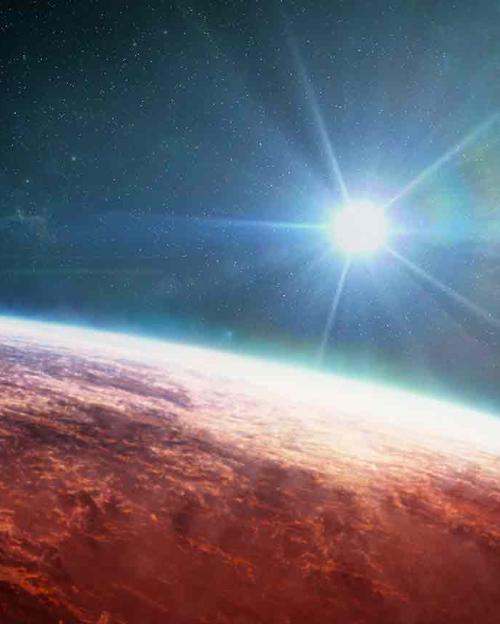Known for beaming stunning images back to Earth, NASA’s James Webb Space Telescope just scored another first: a molecular and chemical portrait of a distant world’s skies.
The telescope’s array of highly sensitive instruments was trained on the atmosphere of a “hot Saturn” – a planet about as massive as Saturn orbiting a star some 700 light-years away – known as WASP-39 b. While Webb and other space telescopes, including Hubble and Spitzer, previously have revealed isolated ingredients of this broiling planet’s atmosphere, the new readings provide a full menu of atoms, molecules and even signs of active chemistry and clouds.
The latest data also hints how these clouds might look up close: broken up rather than a single, uniform blanket over the planet.
The findings bode well for the capability of Webb’s instruments to conduct the broad range of investigations of exoplanets – planets around other stars – hoped for by the science community. That includes probing the atmospheres of smaller, rocky planets like those in the TRAPPIST-1 system.
“We are going to be able to see the big picture of exoplanet atmospheres. It is incredibly exciting to know that everything is going to be rewritten. That is one of the best parts of being a scientist,” said Laura Flagg, a member of the international science team. She is a postdoctoral fellow in the research group of Ray Jayawardhana, the Harold Tanner Dean of Arts and Sciences and Hans A. Bethe Professor in the College of Arts and Sciences at Cornell.
The suite of discoveries is detailed in a set of five new scientific papers which have not yet been published. Among the unprecedented revelations is the first detection in an exoplanet atmosphere of sulfur dioxide, a molecule produced from chemical reactions triggered by high-energy light from the planet’s parent star. On Earth, the protective ozone layer in the upper atmosphere is created in a similar way.
“This is the first time we see concrete evidence of photochemistry – chemical reactions initialized by energetic stellar light – on exoplanets,” said Shang-Min Tsai, a researcher at the University of Oxford in the United Kingdom and lead author of the paper explaining the origin of sulfur dioxide in WASP-39 b’s atmosphere.
At an estimated temperature of 1,600 degrees Fahrenheit and an atmosphere made mostly of hydrogen, WASP-39 b is not believed to be habitable. But the new work points the way to finding evidence of potential life on a habitable planet.
The planet’s proximity to its host star – eight times closer than Mercury is to our sun – also makes it a laboratory for studying the effects of radiation from host stars on exoplanets. Better knowledge of the star-planet connection should bring a deeper understanding of how these processes create the diversity of planets observed in the galaxy.
Other atmospheric constituents detected by the Webb telescope include sodium, potassium and water vapor, confirming previous space and ground-based telescope observations as well as finding additional water features, at longer wavelengths, that haven’t been seen before.
Webb also saw carbon dioxide at higher resolution, providing twice as much data as reported from its previous observations. Meanwhile, carbon monoxide was detected, but obvious signatures of both methane and hydrogen sulfide were absent from the Webb data. If present, these molecules occur at very low levels, a significant finding for scientists making inventories of exoplanet chemistry in order to better understand the formation and development of these distant worlds.
Capturing such a broad spectrum of WASP-39 b’s atmosphere was a scientific tour de force, as an international team numbering in the hundreds independently analyzed data from four of the Webb telescope’s finely calibrated instrument modes. They then made detailed inter-comparisons of their findings, yielding yet more scientifically nuanced results.
Webb views the universe in infrared light, on the red end of the light spectrum beyond what human eyes can see; that allows the telescope to pick up chemical fingerprints that can’t be detected in visible light. Each of the three instruments even has some version of the “IR” of infrared in its name: NIRSpec, NIRCam, and NIRISS.
“Each instrument observed WASP-39 b as it transited across the face of its star, allowing for its star’s light to filter through the planet’s atmosphere. Like a cosmic fingerprint, each molecule in the planet’s atmosphere uniquely absorbs different colors of the star’s spectrum. Therefore, the missing colors in the stellar spectrum tell us which molecules are present,” said Jake Turner, a member of the international science team. He is a NASA Hubble/Sagan postdoctoral fellow in Jayawardhana’s group and a member of Cornell’s Carl Sagan Institute.
Having such a complete roster of chemical ingredients in an exoplanet atmosphere also gives scientists a glimpse of the abundance of different elements in relation to each other, such as carbon-to-oxygen or potassium-to-oxygen ratios. That, in turn, provides insight into how this planet – and perhaps others – formed out of the disk of gas and dust surrounding the parent star in its younger years.
WASP-39 b’s chemical inventory suggests a history of smashups and mergers of smaller bodies called planetesimals to create an eventual goliath of a planet. It also suggests that oxygen is more abundant than carbon in the atmosphere.
By so precisely parsing an exoplanet atmosphere, the Webb telescope’s instruments performed well beyond scientists’ expectations. “This is great news for the suite of planets that will be studied by fellows here at the Carl Sagan Institute,” said Turner.





